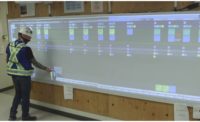Industry technology professionals gathered in San Francisco June 3-5 to study the future of construction technology. ENR FutureTech attracted more than 700 attendees who came to shop for new technologies, gain insights to help make strategic decisions and learn how other firms are innovating and solving problems.

Interest and investment in construction technology has grown steadily in recent years, and professionals came to find out what innovations are worth their time. T.G. Jayanth, capital projects expert for McKinsey & Co., updated attendees on the database of research his firm has been building about construction technology.
When reporting at FutureTech in 2017 after a year of research on 1,000 companies, McKinsey identified three data clusters with the greatest activity—project execution, digital collaboration and back-office work. Further research in 2018 on 2,500 companies identified growing activity around artificial intelligence and advanced analytics.
“Our update for this year is not complete yet,” Jayanth said, but for “early results, one thing we are seeing that’s very encouraging now is that integration is happening.” He pointed to open APIs doing an “enormous favor to our industry,” with even completely separate technology systems now exchanging data. He also noted that a big chunk of the investment in construction technology is in acquisitions. “When I’m an Autodesk acquiring PlanGrid, or Bentley buying Synchro, one of the first things that they’re trying to do is to integrate their solutions. That’s good for all of us,” Jayanth said.
Sharing data for the greater benefit of the collective industry was a theme at FutureTech, where presenters spoke of the benefits other market sectors have found in pooling their data to look for clues to better performance.
In her keynote speech, Suffolk executive vice president and chief data officer Jit Kee Chin explained how predictive analytics—a statistical technique that mines data to make machine-learning-based predictions—will play a crucial role in worksite safety efforts in the next five years. Predictive analytics can also help organizations anticipate schedule problems due to unforeseen events, quality control issues, supply-chain pricing fluctuations and asset management, she said.
Chin noted there are limits to the power of predictive analytics because the tool recommends actions that address aggregate, rather than specific, risk gleaned from large amounts of data organized and assessed over months and years. In a follow-up panel with a group of companies volunteering their data to be analyzed by predictive analytics, Barton Malow vice president of systems Lindsey Rem saw great potential in the initiative.
“We can’t do it alone, and we believe that industry change, true transformation in the construction industry, is not going to happen by any one company, any one technology,” Rem said. Panelists say participating companies’ data is scrubbed for confidentiality—and the more companies that participate and reveal their worksite experiences, the better odds that the analysis will accelerate industry-wide advances in business practices and safety.
But it’s not all fun and sharing in the world of construction. Malicious hacking and ransomware are growing threats to the industry, and a panel of experts agreed that construction is lagging in cybersecurity best practices. “Construction doesn’t take [cybersecurity] as seriously as it should,” said Scott Takaoka, vice president at Aon Cyber Solutions. “Risks are changing—not just loss of data, but critical systems. Data can be taken down for a day, week or month … have your team ready before a breach.”
On the hands-on side of technology, a panel on “Blue-Collar BIM” drew some strong opinions on ownership of the model. Robert Kipp, general superintendent with Satterfield & Pontikes Construction, emphasized the need to get builders on the construction site involved in BIM. “The way to save money is to figure things out in the field,” he said. “Most modelers are not builders.”
Many attendees expressed concern about the skilled labor shortage, and a market update from Dodge Data & Analytics put things into context. Economic tailwinds remain strong for the construction market, with 39% of contractors surveyed saying their backlog has increased and 60% planning to hire more workers in the next six months, said Steve Jones, Dodge’s senior director of industry insights research. However, labor shortages—especially in the concrete and electrical trades—are causing contractors to pile more work on existing employees. “This is not a scalable solution,” Jones told the crowd.
Additionally, rising materials prices, trade tensions and increasing trade deficits will likely lead to a cyclical downturn in the construction market later in 2020 and into 2021, Dodge projects. But this dip isn’t “going to be long, or deep,” barring any surprises, Jones adds.
Judging by the crowd’s reaction, many attendees came looking for solid solutions to systemic problems, rather than quick tech fixes. An online poll run through the FutureTech app during the event found attendees most concerned about the impact of modularization and improving decision-making in preconstruction, while increased use of robots and automation are seen primarily as a way to close the skilled labor gap and bring costs down.
By Jeff Rubenstone, Erica Berardi, Jan Tuchman, Aileen Cho and Scott Blair











Post a comment to this article
Report Abusive Comment